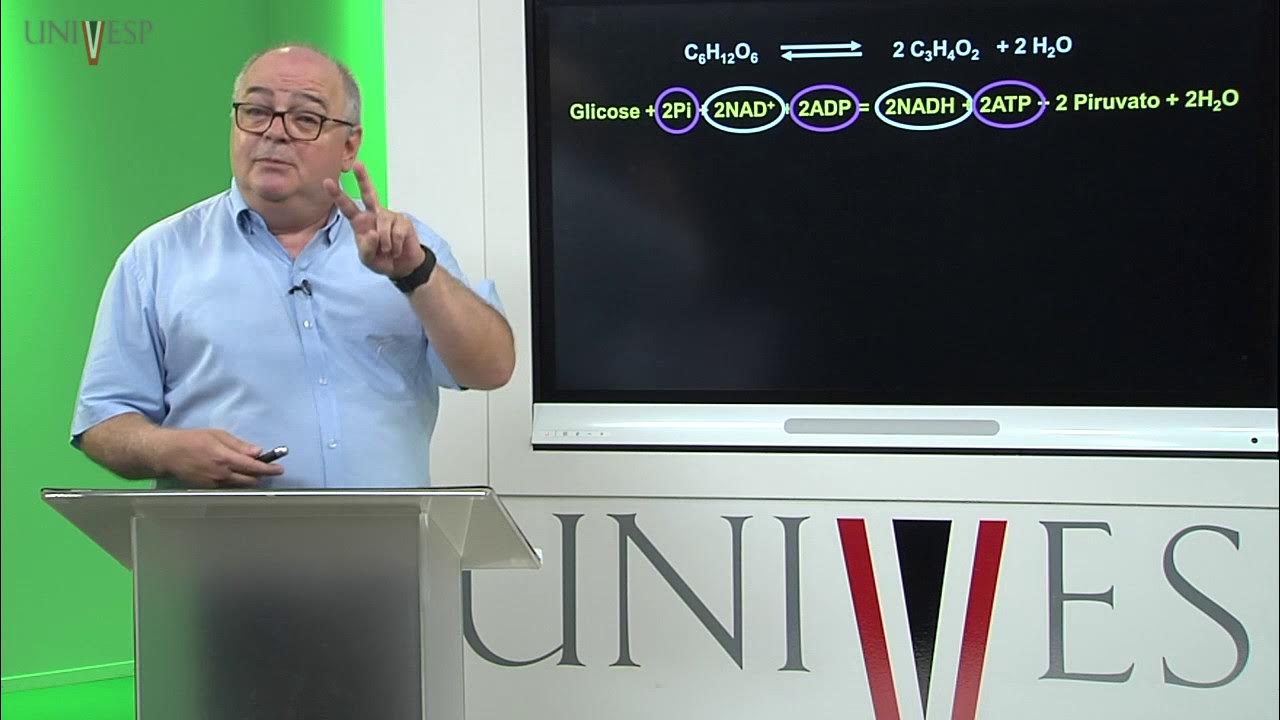Bioquímica - Aula 10 - O sentido das reações metabólicas
Summary
TLDRIn this bioinformatics lecture, Professor Ângelo Cortel ASO explores the concept of spontaneous and non-spontaneous chemical reactions in metabolism. He explains how the spontaneity of reactions is influenced by thermodynamics, focusing on key principles such as enthalpy, entropy, and Gibbs free energy. The lecture delves into the relationship between these factors and their role in biochemical reactions, providing practical examples like ATP breakdown and its coupling with other reactions to drive metabolism. The importance of understanding Gibbs free energy and how it governs metabolic processes is emphasized for a comprehensive understanding of biochemical mechanisms.
Takeaways
- 😀 Reactions in metabolism are crucial for understanding how the body functions and its ability to adapt to various conditions.
- 😀 Spontaneous reactions occur without regard to their speed; what matters is their direction, not their rate of occurrence.
- 😀 Enzymes do not change the spontaneity of reactions, but they accelerate them by lowering activation energy.
- 😀 The first law of thermodynamics states that energy in an isolated system is constant, meaning energy can only be transformed, not created or destroyed.
- 😀 The second law of thermodynamics suggests that natural processes increase entropy, leading to more disorder unless energy is used to counteract it.
- 😀 Exothermic reactions release energy, usually as heat, and have a negative enthalpy change (ΔH < 0), while endothermic reactions absorb energy (ΔH > 0).
- 😀 The spontaneity of a reaction can be determined by the change in free energy (ΔG). Spontaneous reactions have ΔG negative.
- 😀 Gibbs free energy (ΔG) helps to predict if a reaction is spontaneous, with a negative ΔG indicating a spontaneous process.
- 😀 The relationship between enthalpy (ΔH) and entropy (ΔS) is essential in determining the spontaneity of reactions, influenced by temperature.
- 😀 Biological reactions, like ATP hydrolysis, are often highly spontaneous, making them almost irreversible without significant changes in reactant or product concentrations.
Q & A
What is the key concept behind spontaneous and non-spontaneous reactions in biochemistry?
-A spontaneous reaction occurs without external input of energy, meaning it naturally proceeds in a certain direction, whereas a non-spontaneous reaction requires external energy to occur. The spontaneity is determined by the change in Gibbs free energy (ΔG), where a negative ΔG indicates spontaneity.
How does enzyme activity affect the spontaneity of a reaction?
-Enzymes speed up the rate of reactions but do not alter the spontaneity. They lower the activation energy, allowing reactions to occur faster, but the direction of the reaction, determined by spontaneity, remains unchanged.
What is the significance of Gibbs free energy (ΔG) in determining the spontaneity of a reaction?
-Gibbs free energy (ΔG) indicates whether a reaction is spontaneous. A negative ΔG means the reaction is spontaneous, while a positive ΔG means the reaction is non-spontaneous. It accounts for both enthalpy and entropy changes in a system.
What are the first and second laws of thermodynamics, and how do they relate to biochemical reactions?
-The first law states that energy cannot be created or destroyed, only transformed. The second law states that in natural processes, entropy (disorder) increases. Biochemical reactions must obey these laws, where energy transformation is key, and entropy increases in spontaneous reactions.
How does enthalpy (ΔH) influence the thermodynamic properties of reactions?
-Enthalpy (ΔH) represents the heat content of a system. In exothermic reactions, ΔH is negative, meaning energy is released. In endothermic reactions, ΔH is positive, meaning energy is absorbed. This change in enthalpy plays a role in determining the spontaneity of a reaction.
What is the difference between standard Gibbs free energy (ΔG°) and the Gibbs free energy under physiological conditions (ΔG'°)?
-ΔG° refers to the standard Gibbs free energy change under ideal conditions (1 M concentration, 25°C, and pH 0), while ΔG'° refers to the Gibbs free energy under physiological conditions, often with a pH of 7, making it more relevant to biological systems.
How is the entropy (ΔS) of a system linked to the spontaneity of a reaction?
-Entropy (ΔS) measures the disorder in a system. A positive ΔS indicates an increase in disorder, which is favorable for spontaneity. In biochemical reactions, processes that increase entropy tend to be spontaneous, following the second law of thermodynamics.
What role does temperature play in determining the spontaneity of reactions?
-Temperature influences the spontaneity of reactions by affecting both enthalpy and entropy. As temperature increases, it can shift the balance between enthalpy and entropy, potentially making reactions that are not spontaneous at lower temperatures become spontaneous at higher temperatures.
What is the relationship between Gibbs free energy (ΔG) and equilibrium constant (K)?
-The relationship is given by the equation ΔG° = -RT ln K, where R is the gas constant, T is the temperature, and K is the equilibrium constant. At equilibrium, ΔG° is zero, and the constant K reflects the ratio of products to reactants at equilibrium.
How do metabolic processes use coupling of reactions to drive otherwise non-spontaneous processes?
-Metabolic processes often couple non-spontaneous reactions with spontaneous ones to drive biochemical processes forward. For example, ATP hydrolysis (which is highly exergonic) can power endergonic reactions (like the phosphorylation of glucose) by coupling their ΔG values, making the overall reaction spontaneous.
Outlines

This section is available to paid users only. Please upgrade to access this part.
Upgrade NowMindmap

This section is available to paid users only. Please upgrade to access this part.
Upgrade NowKeywords

This section is available to paid users only. Please upgrade to access this part.
Upgrade NowHighlights

This section is available to paid users only. Please upgrade to access this part.
Upgrade NowTranscripts

This section is available to paid users only. Please upgrade to access this part.
Upgrade Now5.0 / 5 (0 votes)





